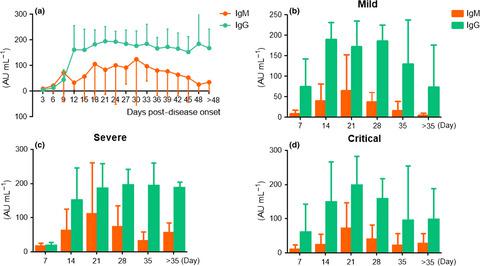当前位置:
X-MOL 学术
›
Clin. Transl. Immunol.
›
论文详情
Our official English website, www.x-mol.net, welcomes your
feedback! (Note: you will need to create a separate account there.)
Detection of IgM and IgG antibodies in patients with coronavirus disease 2019.
Clinical & Translational Immunology ( IF 4.6 ) Pub Date : 2020-05-06 , DOI: 10.1002/cti2.1136 Hongyan Hou 1 , Ting Wang 1 , Bo Zhang 1 , Ying Luo 1 , Lie Mao 1 , Feng Wang 1 , Shiji Wu 1 , Ziyong Sun 1
Clinical & Translational Immunology ( IF 4.6 ) Pub Date : 2020-05-06 , DOI: 10.1002/cti2.1136 Hongyan Hou 1 , Ting Wang 1 , Bo Zhang 1 , Ying Luo 1 , Lie Mao 1 , Feng Wang 1 , Shiji Wu 1 , Ziyong Sun 1
Affiliation

|
Objectives
This study aimed to determine the IgM and IgG responses against severe acute respiratory syndrome coronavirus (SARS-CoV)-2 in coronavirus disease 2019 (COVID-19) patients with varying illness severities.
Methods
IgM and IgG antibody levels were assessed via chemiluminescence immunoassay in 338 COVID-19 patients.
Results
IgM levels increased during the first week after SARS-CoV-2 infection, peaked 2 weeks and then reduced to near-background levels in most patients. IgG was detectable after 1 week and was maintained at a high level for a long period. The positive rates of IgM and/or IgG antibody detections were not significantly different among the mild, severe and critical disease groups. Severe and critical cases had higher IgM levels than mild cases, whereas the IgG level in critical cases was lower than those in both mild and severe cases. This might be because of the high disease activity and/or a compromised immune response in critical cases. The IgM antibody levels were slightly higher in deceased patients than recovered patients, but IgG levels in these groups did not significantly differ. A longitudinal detection of antibodies revealed that IgM levels decreased rapidly in recovered patients, whereas in deceased cases, either IgM levels remained high or both IgM and IgG were undetectable during the disease course.
Conclusion
Quantitative detection of IgM and IgG antibodies against SARS-CoV-2 quantitatively has potential significance for evaluating the severity and prognosis of COVID-19.
中文翻译:

2019年冠状病毒病患者IgM和IgG抗体检测。
目的 本研究旨在确定不同疾病严重程度的 2019 年冠状病毒病 (COVID-19) 患者对严重急性呼吸综合征冠状病毒 (SARS-CoV)-2 的 IgM 和 IgG 反应。方法通过化学发光免疫测定法评估 338 名 COVID-19 患者的 IgM 和 IgG 抗体水平。结果 大多数患者的 IgM 水平在 SARS-CoV-2 感染后第一周内升高,并在 2 周内达到峰值,然后降至接近背景水平。1周后可检测到IgG,并长期维持在高水平。轻症、重症、危重症组间IgM和/或IgG抗体检测阳性率无显着差异。重症、危重症病例IgM水平高于轻症病例,危重症病例IgG水平低于轻症、重症病例。这可能是因为危重病例中疾病活动性高和/或免疫反应受损。死亡患者的 IgM 抗体水平略高于康复患者,但这些组中的 IgG 水平没有显着差异。抗体的纵向检测显示,康复患者的 IgM 水平迅速下降,而在死亡病例中,IgM 水平要么保持较高水平,要么在病程中 IgM 和 IgG 均检测不到。结论 定量检测 SARS-CoV-2 IgM 和 IgG 抗体对评估 COVID-19 的严重程度和预后具有潜在意义。
更新日期:2020-05-06
中文翻译:

2019年冠状病毒病患者IgM和IgG抗体检测。
目的 本研究旨在确定不同疾病严重程度的 2019 年冠状病毒病 (COVID-19) 患者对严重急性呼吸综合征冠状病毒 (SARS-CoV)-2 的 IgM 和 IgG 反应。方法通过化学发光免疫测定法评估 338 名 COVID-19 患者的 IgM 和 IgG 抗体水平。结果 大多数患者的 IgM 水平在 SARS-CoV-2 感染后第一周内升高,并在 2 周内达到峰值,然后降至接近背景水平。1周后可检测到IgG,并长期维持在高水平。轻症、重症、危重症组间IgM和/或IgG抗体检测阳性率无显着差异。重症、危重症病例IgM水平高于轻症病例,危重症病例IgG水平低于轻症、重症病例。这可能是因为危重病例中疾病活动性高和/或免疫反应受损。死亡患者的 IgM 抗体水平略高于康复患者,但这些组中的 IgG 水平没有显着差异。抗体的纵向检测显示,康复患者的 IgM 水平迅速下降,而在死亡病例中,IgM 水平要么保持较高水平,要么在病程中 IgM 和 IgG 均检测不到。结论 定量检测 SARS-CoV-2 IgM 和 IgG 抗体对评估 COVID-19 的严重程度和预后具有潜在意义。











































 京公网安备 11010802027423号
京公网安备 11010802027423号